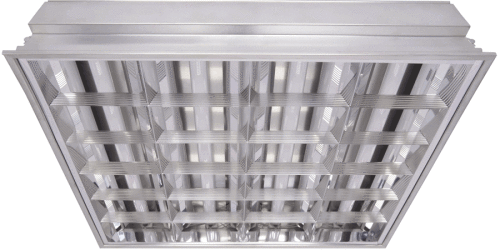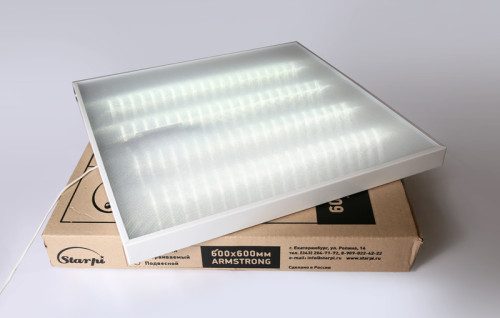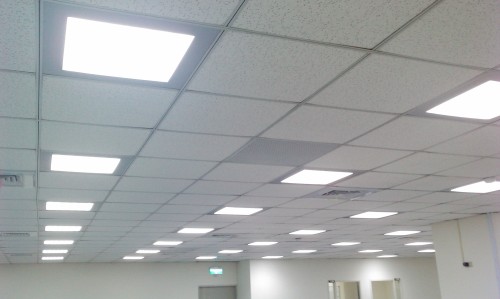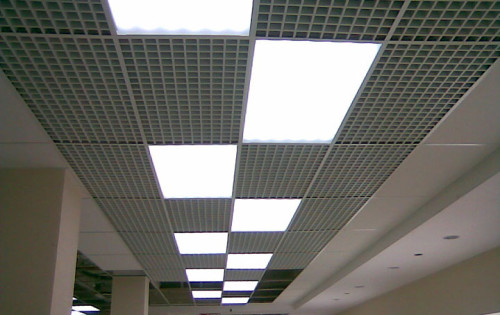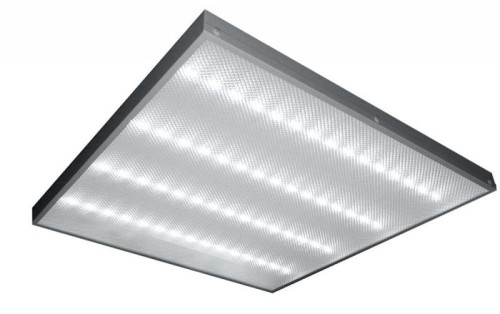
Ceiling lamps Armstrong: choice and installation Lighting
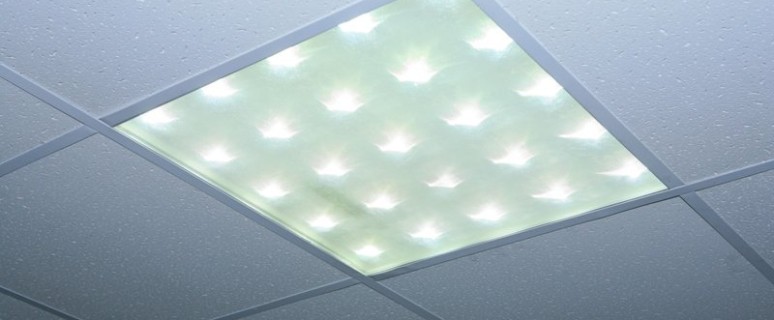
Armstrong lamps are lighting devices designed to embed in the suspended ceiling. On the peculiarities, species, pluses and minuses of such lamps, as well as on the intricacies of their installation, we will tell in this article.
Content
Quick description Armstrong lamps
Armstrong lamps were named so on the name of the company that first submitted this product on the market of our country. Lighting devices of this type are structures mounted from profiles and embedded in the suspended ceiling instead of some of its sections. The standard dimensions of the ceiling lamps Armstrong are equal to 600x600 mm - slabs of suspended ceilings have the same dimensions. Lighting structures are installed in the ceiling together with its other parts, creating a smooth single-level surface as a result. Dismantling the lamps also does not represent difficulties, so if necessary, the design can be easily removed, and then put in place.
Armstrong lamp device diagram is quite simple. A group of LEDs is connected to the blocks that are subsequently fixed on the base of the lamp. These LEDs are connected to each other, creating a single chain. Then the lamp is connected to the total power supply network through a lowering transformer.
As for the power of the lamps, it can be different and directly depends on how many LEDs were used when creating a structure. Among other things, each similar device is equipped with a cooling radiator.
The scope of the use of lighting structures is quite wide. Most often, Armstrong lamps can be found in office, industrial and warehouses, factories and in large shopping centers, at train stations, in stores and in supermarkets, airports and classroom schools. Such a type of lighting will be infrequently visiting in residential rooms like halls, bedrooms, living rooms. The thing is that the glow from the instruments of Armstrong is cold enough and does not create the necessary coziness. But in the bathrooms and in the hallways, the lamps of this type are popular.
Armstrong lamps: pros, cons, main characteristics
Before you buy the ceiling lamps Armstrong, it should be read as much as possible with their main features, study the positive and negative qualities of the structures. It should be noted that on the Russian market, the lamps of this type are considered one of the most popular goods. Such demand is due to the high operational properties of products, as well as its economy. The use of such lamps allows to save significant funds, since, unlike conventional incandescent lamps, Armstrong lamps consume several times less electricity. Especially such savings will be noticeable if the lighting devices are used in large quantities in the extensive areas.
The advantages of lamps Armstrong would like to consider Read more:
- Among the elements of the lamps design there are special anti-vandal protection, which also performs the functions of the diffuser. Anti-vandal protection not only protects LEDs from damage, which may occur as a result of external mechanical effects, but also contributes to uniform diffusion of light by room.
- Built-in ceiling lamps Armstrong lightly illuminate the room. The maximum number of LEDs in such structures is 32, which allows you to get a great level of lighting.
- The lamps are also equipped with an aluminum cooling radiator, the role of which is to protect LEDs from overheating and extending their operation. We add that the LED service life reaches 50,000 hours of continuous use.
- In the course of its work, the lamps Armstrong absolutely do not make noise.
- If the voltage in the network is sharply reduced or rises, the lighting devices of this type do not flicker.
- LED lamps do not contain mercury in their composition, therefore, they are considered environmentally friendly and secure. In addition, with the disposal of lamps, which served their time, no problems will arise.
- Light from such devices is obtained scattered and uniform, which makes it easy to highlight every corner of the room.
- The positive properties of such lamps include simplicity of their installation. If the need to remove the design to get to the communications laid behind it, dismantling is fairly easy.
As you can see, the lamps of this type have a number of positive qualities. But you can not forget about the lack of structures, consider them in more detail:
- The price of embedded ceiling lamps Armstrong is quite high. Acquire them solve those who sees real savings of money in the case of using such devices. For example, the owners of large areas of premises will be able to save significant amounts of money for electricity. But in the case of small rooms or premises, where artificial light is rarely used, the costs of lamps Armstrong will not always be justified.
- A variety of species and forms of such devices are small, so to enter them into any design is unlikely to succeed. Armstrong lamps are best suited for rooms weathered in strict minimalist style.
- The light emitted by such devices has a cold spectrum, so Armstrong lamps will not add comfort room. In addition, cold lighting with prolonged exposure is a little tired.
- Approximately 3-4 years of operation, part of the LEDs can become more dull or at all flicker, so over time they will have to be replaced with new ones.
Varieties of lamps Armstrong
Depending on which lamps are used in the ceiling light design, fluorescent and LED lamps distinguish. Many prefer to set luminescent lamps, and the reason for this lies in their relatively low price. However, Armstrong LED ceiling lamps are considered a more profitable and economical option. Consider the comparative characteristics of these two varieties of devices:
- The duration of operation in LED structures is much higher than that of luminescent. Luminaires equipped with fluorescent lamps can last no longer than 10,000 hours of continuous operation, and in their more expensive analogue this figure is up to 50,000 hours.
- Electricity consumption in LED and fluorescent lamps is also different. The lamp, equipped with fluorescent lamps, consumes about 120 W, while LED devices require only 45 watts.
- With relatively low power, LED Armstrong lamps provide much more brighter lighting than their fluorescent counterparts. The reason lies in various corners of lighting. LED lamps have an angle of lighting equal to 240 °, while the rays are directed directly to the illuminated surface. Luminescent lamps have more scattered light, and if there are no special reflectors on the ceiling, the lighting will disappear.
- LED designs are considered more environmentally friendly and safe for the environment, since they do not have mercury.
- LED lamps in the process of their work are not emitted ultraviolet.
Using Armstrong Lamps in the Interior
Armstrong lamps do not have a wide variety of forms, but with their help you can create quite interesting interior designs. Thanks to the embedded design, such lamps do not overload space and do not occupy an excess place.
Very well, such lighting designs look in combination with stretch ceilings, and during the installation of lamps Armstrong in the suspended ceiling, you can get a smooth single-level surface that looks neat and concise.
The design of some luminaires allows them to use them in narrow rooms like corridors and hallways. In addition, Armstrong lamps are resistant to moisture, so they can be easily installed in the bathrooms and in the kitchens. Often, such structures perform the functions of the main lighting, although in some cases the lamps serve as a decorative addition to the chandelier.
Armstrong ceiling lamps can very often find in office space, because good lighting is an important condition for productive work. Unobtrusive, strict, concise design of such lamps can fit into any office. Such devices are not distinguished against the background of the overall style of the room, and their cold scattered light adjusts to the working way.
Calculation of the number of lamps Armstrong for the room
By defining how many lighting devices are needed to illuminate one or another room, it is necessary to rely on the rules and norms prescribed in the regulatory documents. The amount of light in public premium rooms, as well as at the production workplaces, should reach an indicator of 100-150 LM to 1M². In rooms like offices, libraries, school and university audiences, as well as in various kinds of laboratories, the lighting should be brighter and equal to 500 LM to 1m². If there are work with small parts, for example, in drawing workshops, the light stream should be equal to at least 1000 lm per 1m².
Based on this data, you can calculate the number of fixtures required for one or another room. To understand which lamps should be purchased, pay attention to the following indicators:
- the luminous flux of the fluorescent lamp of 4 W will be 120 lm;
- 8 W light bulb will have an indicator of 450 LM;
- 15 W power lamp will give a light stream equal to 950 LM;
- for a luminescent lamp with 18 W power, this indicator will be equal to 1350 LM.
As for LED lamps, the numbers here will be somewhat different:
- lED lamp in 4 W emits 400 lm;
- light bulb with 8 W power gives a light stream of 700 lm;
- 10 W lamp radiates a stream of 900 lm;
- the device with 15 W power has an indicator of 1200 lm.
As you can see, the LED lamps will be more profitable from the point of view of savings, especially if the room is quite large and lamps require a lot. But when calculating the number of lighting devices, it is important to take into account not only their power, but also some other factors, for example, the height of the ceiling of the room. It is known that the higher the lamp above the illuminated surface will be, the lower the illumination will be. For example, if Armstrong lamp is placed in 1 m above the surface, the light level will be approximately 1000 lm, but if you raise the device 0.5 m above, the light stream will decrease to 450 lm. At an altitude of 3 m, this indicator will be equal to 115 lm.
Other factors affecting the level of light illumination are room dimensions, shades of walls, gender and ceiling, glossiness of surfaces. The structural features of the device itself possess an important meaning. For example, if the lamp is equipped with a matte diffuser, the light transmission coefficient will be only 70%. A higher indicator has devices with diffusers made of lighting polystyrene. Such lamps have a light flux transmission coefficient equal to 85%. The best lights are missing devices equipped with prismatic or microprismatic hypercraft diffusers. In such lamps, the light transmission coefficient reaches 90%.
Installation of lamps Armstrong on the ceiling
Consider in more detail the features of the installation of Armstrong lamps. For example, we take the design of standard dimensions of 600x600 mm. The installation of the lamp will be made in the Armstrong ceiling or in any other suspended ceiling of plasterboard. The whole process can be described in the form of such steps:
- Before you start work, determine the cells on the ceiling that the lamps will be installed. In these places, dismantle the ceiling panels and move the luminaire of the power supply wire to the place of installation.
- Remove the lamp from the box in which it was purchased. Then remove the protective polyethylene film, as well as remove the diffuser.
- Electric pipes located inside the Armstrong lamp housing, connect to the terminal block. Do not forget to connect the grounding wire. Also note that any fixture installation work must be carried out only when the nutrition network is de-energized.
- Armstrong lamps are connected to the terminal block using mounting cables, whose cross section is not less than 0.75 mm².
- After connecting the lighting devices to a common power grid, the diffuser can be installed in place.
There are cases when the lamps are not embedded in the ceiling, and they are assembled directly on its surface. This process would also be considered to consider:
- Unpack the lamp, free it from the protective film and remove the diffuser.
- Choose a seat on the ceiling where the device will be mounted. Put the hole in the surface of the ceiling in such a way that they match the holes located on the luminaire itself.
- Using dowels and self-tapping screws, fix the lighting device on the ceiling. Then connect it to the power grid through the terminal block, without forgetting to connect the ground wire.
- The final stage put the diffuser in place.
Ceiling lamps Armstrong, photo:




